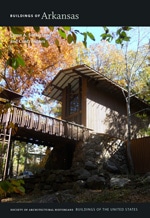The Ohio Club was built for Otis McGraw to serve as a private gambling hall and saloon. The small building is two stories in height, with a mezzanine and a gabled facade, and its second story is fronted entirely by a semi-circular bay of pointed-arched windows and crowned by a half dome, painted gold. The windows have blue surrounds, and the gable also is blue. The entire effect is slightly exotic. Pressed metal imitating rusticated stone is used for the corner pilasters, which are topped by finials carried on large brackets. The ground floor front of the store has been altered over the years, but the original transom remains. The interior, intended to appeal to men of means as a private club, still contains the original Italian mahogany bar. During Prohibition the lower part of the business become the Ohio Cigar Store, but illegal gambling was a fixture in the building until it was finally closed down in the mid-1960s.
The three-story building next door (number 332) with a metal front was constructed c. 1890 as the Nicholas Hotel. Its single second-story bay window echoes that of the Ohio Club and was probably added c. 1910 when the hotel was remodeled to become the Saratoga Hotel; the building is now known as the Plaza Hotel. On the other side of the Ohio Club is the five-story Thompson Building (1913, George Mann), an office building with a richly detailed Classical Revival design faced in white-glazed terra-cotta, typical of Mann’s work in this period. The facade is dominated by a row of fluted Corinthian columns that rise from the top of the first floor to conclude above the fourth in an extravagant entablature.


